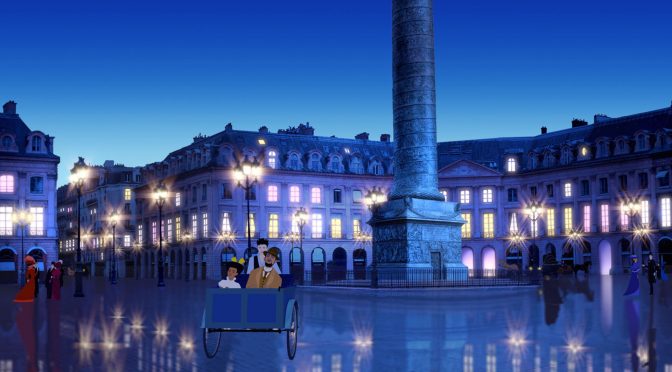« Be careful, we shouldn’t step back. »
Marie Curie
 With the help of her delivery-boy friend, Dilili, a young Kanak, investigates a spate of mysterious kidnappings of young girls that is plaguing Belle Époque Paris. In the course of her investigation she encounters a series of extraordinary characters, each of whom provides her with clues that will help her in her quest… The two friends will fight with enthusiasm for an active life in the light and in peaceful coexistence…
With the help of her delivery-boy friend, Dilili, a young Kanak, investigates a spate of mysterious kidnappings of young girls that is plaguing Belle Époque Paris. In the course of her investigation she encounters a series of extraordinary characters, each of whom provides her with clues that will help her in her quest… The two friends will fight with enthusiasm for an active life in the light and in peaceful coexistence…
Dilili à Paris, by Michel Ocelot, is an animation where Paris becomes a character. We explore the City of Light, from the smallest anonymous spots to the most renowned places. We meet surprising characters who have marked History and many other who changed the face of art by revealing its diversity.
 Each encounter Dilili makes is more wonderful than the last. This movie pays tribute to more than 100 personalities from the 1900’s, including Renoir, Rodin, Monet, Degas, Camille Claudel, Douanier Rousseau, Picasso, Colette, Proust, Gide, Anna de Noailles, Ravel, Louise Michel, Debussy, the Prince of Wales (Edouard VII), Pasteur, Méliès, the Lumière brothers, Eiffel, Marie Curie, Sarah Bernhardt and Chocolat.
Each encounter Dilili makes is more wonderful than the last. This movie pays tribute to more than 100 personalities from the 1900’s, including Renoir, Rodin, Monet, Degas, Camille Claudel, Douanier Rousseau, Picasso, Colette, Proust, Gide, Anna de Noailles, Ravel, Louise Michel, Debussy, the Prince of Wales (Edouard VII), Pasteur, Méliès, the Lumière brothers, Eiffel, Marie Curie, Sarah Bernhardt and Chocolat.
Paris in pictures
 Dilili à Paris’ sets are not drawn like the characters are; they are actually made from Paris photographs, real images that have been reworked and re-painted. To obtain such a result, Michel Ocelot took pictures of the city and its charms over a period of four years.
Dilili à Paris’ sets are not drawn like the characters are; they are actually made from Paris photographs, real images that have been reworked and re-painted. To obtain such a result, Michel Ocelot took pictures of the city and its charms over a period of four years.
His choice is aesthetic: “When I watch the Opera, and its gold-dripping Grand Foyer, I don’t see myself redoing all that with my limited graphic palette. I also celebrate the Art Nouveau style with its extraordinary objects, playing with different shapes and materials in a refined packaging. We cannot do better than what the great artisans took their whole life to accomplish.” (free translation)
 But his work was complex. He had to try to photograph each setting with the least people possible. Besides people, all traces of modernity needed to disappear from his shots to fit with the chosen epoch: cars, motorcycles, bikes, trash cans, posters, etc. And he bet on light, on Paris under the sun. I consider the result to be a visual success.
But his work was complex. He had to try to photograph each setting with the least people possible. Besides people, all traces of modernity needed to disappear from his shots to fit with the chosen epoch: cars, motorcycles, bikes, trash cans, posters, etc. And he bet on light, on Paris under the sun. I consider the result to be a visual success.
A unifying message
Contrary to many fairytales or more traditional animated films, the discourse is feminist. Women are just as intelligent as men and can hold important and/or prestigious roles.
The characters tackle racism, misogyny and other forms of rejection up front. Everything is well treated, in a language simple enough for a young audience to be able to understand. And a little fantasy is added to the whole.
 Guided by her friend, Dilili has the chance to meet the capital’s most prominent people and most famous inventors. She writes down the names of those she meets in a notebook and imagines herself holding their functions/positions. This child sets no limits to herself; her status as a Métis woman does not represent an obstacle to her ambitions. An inspiring example for many young girls!
Guided by her friend, Dilili has the chance to meet the capital’s most prominent people and most famous inventors. She writes down the names of those she meets in a notebook and imagines herself holding their functions/positions. This child sets no limits to herself; her status as a Métis woman does not represent an obstacle to her ambitions. An inspiring example for many young girls!
But still…
The story is quite Manichean: with good guys and bad guys. A binary division of the world. The film is aimed at a young audience and this approach helps simplify the subject. But the fact remains that some shortcuts are taken here and there.
 Indeed, the meeting between the two acolytes, at the very beginning of the film, bothered me. The intense interest on the part of the young man is surprising. It would have made more sense if he had met the girl during one of her errands at one of her prestigious “friends”.
Indeed, the meeting between the two acolytes, at the very beginning of the film, bothered me. The intense interest on the part of the young man is surprising. It would have made more sense if he had met the girl during one of her errands at one of her prestigious “friends”.
Dilili à Paris remains a pleasant family movie, it’s educational and very beautiful visually. Travel through the Paris of the Belle Époque to meet impressive people who lived there.
Score: 7/10
You can watch the trailer:
Translation by Jean-Sébastien Bourret








